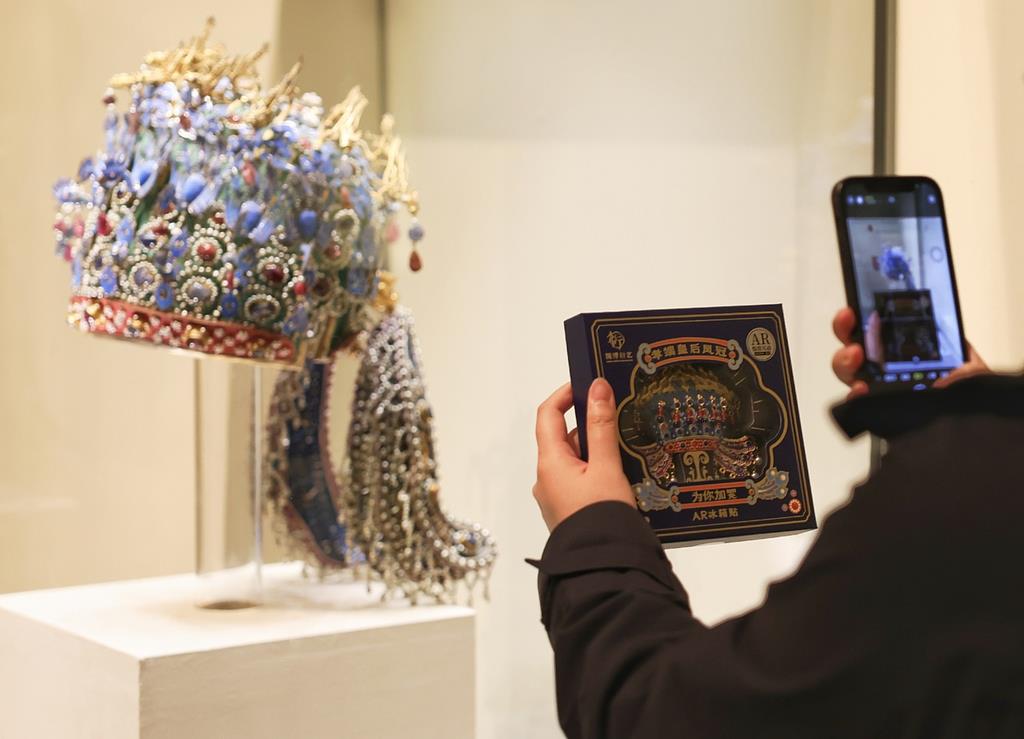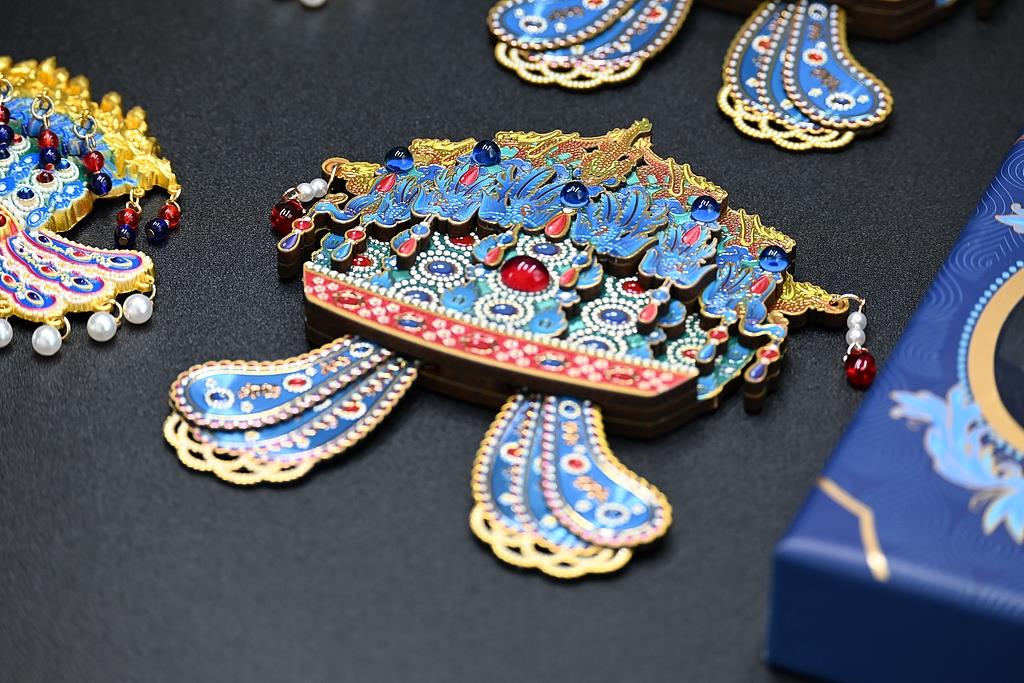From the archaeological blind box of the Henan Museum to the “fat sword” of the Suzhou Museum, to the “green horse” of the Gansu Provincial Museum, these cultural and creative products are either exquisite, humorous, or ugly… In recent years, cultural and creative products that are full of variety and constantly “come out of the circle” have been loved by more and more consumers.
Like the National Museum’s Phoenix Crown refrigerator sticker, after its launch, it quickly became a phenomenal hit product, and it is hard to find a “crown”. Yesterday (25th), its sales exceeded 1 million pieces, and at the same time, it drove the sales of Fengguan IP products to exceed 100 million yuan, becoming the well-deserved “sales champion” of Guobo in the past 20 years.
The museum’s cultural and creative culture has built a “bridge” for the organic integration of Chinese culture and modern life, allowing history and art to be integrated into people’s lives. Purchasing cultural and creative products has become a trendy trend, and “bringing museums home” has become a new consumption fashion.
What kind of profound cultural heritage is reflected behind the “out of the circle” of cultural and creative products? From derivatives development to “bringing museums home”, how can we truly bring cultural relics to life? Come and listen to the report by Liu Mengya, a reporter from China Voice of China:
On March 25, the cumulative sales of the National Museum’s phenomenal cultural and creative industry, Phoenix Crown Refrigerator Stickers, exceeded 1 million pieces. Ms. Li, a tourist from Dongying, Shandong, was lucky to become the buyer of the 1 millionth piece of Phoenix Crown Refrigerator Stickers and obtained the “Commemorative Phoenix Crown Refrigerator Stickers” and commemorative certificate.
Ms. Li: We have seen this refrigerator sticker on many platforms before and I really want to buy it. This time I came to queue up to buy it. I got it after making an appointment. When I really got this cultural and creative industry, I felt that the distance between the cultural relics was closer. I looked at the cultural relics again after a while and looked at them carefully.

Last year (2024), the National Museum designed the phoenix crown refrigerator sticker inspired by the Nine Dragons and Nine Phoenix crown of Empress Ming Xiaoduan, once launched, triggered a craze for queuing up for buying, and once the phenomenon of “hard to get a crown”. Liao Fei, general manager of Guobo (Beijing) Cultural Industry Development Co., Ltd., introduced that at present, with the continued popularity of Fengguan refrigerator patches, production capacity is also increasing.
Liao Fei: Since the two types of refrigerator stickers for wood and metal were sold in mid-July 2024, the cumulative sales volume has reached 1 million pieces. This is a phenomenal presentation in the past 20 years, both in the National Blog and the Cultural and Arts industry. During the sale process, we have been purchasing from the earliest wooden refrigerator-stick limited to purchase 200 pieces to 500 pieces, to the current offline purchase limit of 1,500 pieces, as our production capacity continues to increase, we are also constantly making dynamic adjustments.

In fact, the popularity of Fengguan refrigerator patches is not accidental, and behind this is the depth of cultural heritage. According to Li Xue, deputy director and associate researcher of the National Museum’s Exhibition Work Department, the Nine Dragons and Nine Phoenix Crown of Empress Xiaoduan of Ming Dynasty was the first national treasure-level cultural relics prohibited from being exhibited abroad. According to the Wanli period of the Ming Dynasty, it has more than 100 red and sapphires and more than 4,000 pearls, which can be said to fully demonstrate the aesthetic style of the royal family in the Ming Dynasty.
Li Xue: This Empress Xiaoduan of Ming Dynasty, the Nine Dragons and Nine Phoenix Crown is currently on display to the public in the exhibition halls of the Ming and Qing Dynasties of ancient China during the basic display, and is also a cultural relic that is loved by the audience. This phoenix crown was unearthed in the Ming Dingling Mausoleum of Changping, Beijing in the 1950s. The phoenix crown was a top hat worn by the queen when she accepted enthronement, worshiped temples and attended court meetings. The height of this phoenix crown is 48.5 cm, the diameter is 23.7 cm, the height of the crown is 27 cm, and the total weight reaches 2320 grams. There are 115 gems and 4414 pearls inlaid on it. The whole thing looks like a golden dragon leaping over the green clouds and a green phoenix flying among the jewelry flowers and leaves, reflecting the unique aesthetic style of the royal family in the Ming Dynasty and also reflecting the ritual system of the Wanli period.
With the continuous heating of the “museum fever” in recent years, the profound historical value and unique artistic charm carried by cultural relics have continued to attract a large number of viewers to queule in with cultural relics. Liao Fei introduced that in response to this hot phenomenon, the Guobo Cultural and Creative Team cleverly transformed cultural relics elements into cultural and creative products close to the public’s life to accurately meet the public’s consumption needs for history and culture.
Liao Fei: These two refrigerators highlight the craftsmanship, because the cultural relics themselves were made by craftsmen at that time with many superb skills. Our wooden refrigerator stickers are divided into three layers, giving it a relatively three-dimensional feel on the plane, and it takes a lot of handmade parts from printing to beading decoration. This is especially true for metal refrigerator stickers. There are 12 small pendants of imitation pearls at the bottom, which require hand-written. Each of the 9 creepings will be worn with a string of beads. All of these require a lot of manual work. We also want to use a small object to reflect people’s intention to treat a craft at that time.
It is understood that the “breaking circle” of Fengguan refrigerator stickers not only drives the coordinated development of upstream and downstream industries such as design, production, and marketing, but also creates employment opportunities for more than 1,000 people, achieving a “double harvest” of social and economic benefits. At the same time, Fengguan IP derivatives have also been developed in matrix form. Up to now, more than 20 related cultural and creative products have been developed and designed, including notebooks, plush toys, horse-faced skirts, ice creams, music boxes, etc., forming a cultural and creative ecological chain of “hot products with long tails”. Liao Fei said that he hopes to use cultural and creative products to further expand the influence of cultural relics, attract more audiences to pay attention to the cultural relics themselves, form a virtuous cycle, and allow more people to feel the charm of China’s excellent traditional culture.
Liao Fei: Before, you may have put more cultural and creative products there when you buy them home, but the popularity of this refrigerator sticker prompts everyone to buy this refrigerator sticker first. After purchasing, he will return to the exhibition hall to find the prototype of this cultural relic. Understanding this cultural relic may lead people to have an understanding of the history of the Ming and Qing Dynasties, and then further have a deep understanding of the history of the entire Chinese history, so a two-way journey has emerged, which is called better completing the combination of exhibition and creation.
Nowadays, more than 90% of the audiences who come to the National Expo will visit the basic exhibition of “Ancient China”. Liao Fei said that on this year’s May 18 International Museum Day, the National Museum will also launch “Ancient Chinese Readers” and an ancient Chinese series of innovative works. These new products have undergone repeated polishing from planning to design and production, striving to deeply explore the historical stories and cultural values behind cultural relics, and bring cultural relics to life in various innovative forms, so that more audiences can “bring the museum home.”
Liao Fei: The National Museum of China has 1.43 million sets of cultural relics in its collection. Thousands of cultural relics are also exhibited in our basic exhibition of “Ancient China”. Among them, we will choose very representative cultural relics to produce products. Now we will update and iterate at the rate of 200 products every year. I think culture can + everything, but now it may be more “cultural relics + technology”. Virtual reality technologies such as AR have actually been used in our products. Through cultural and creative products, we can enter thousands of households to make cultural relics come alive, so that everyone can learn more about the stories behind cultural relics, and young people can go to museums more to think about Chinese culture, which is a phenomenon that we are particularly happy to see.
[Editor in charge: Ma Rui]








